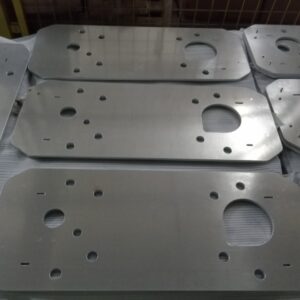Quality inspection for sheet metal parts is crucial to ensure that the products meet specified standards and requirements. Here are the key aspects and methods involved in inspecting sheet metal parts:
Dimensional Inspection
- Measurement Tools: Use calipers, micrometers, and height gauges to measure dimensions such as length, width, thickness, and diameter.
- Coordinate Measuring Machine (CMM): For precise measurement of complex geometries and to compare the part against CAD models.
- Laser Scanners: For non-contact measurement and detailed surface inspection.
Visual Inspection
- Surface Finish: Check for surface defects such as scratches, dents, and blemishes.
- Coating Quality: Inspect the quality of paint or other coatings for uniformity and adherence.
- Weld Quality: Examine welds for defects like cracks, porosity, and improper penetration.
Material Inspection
- Material Thickness: Verify the thickness of the sheet metal using micrometers or ultrasonic thickness gauges.
- Hardness Testing: Measure the hardness of the metal to ensure it meets material specifications.
- Material Composition: Use spectrometers or chemical analysis to verify the composition of the metal.
Geometrical Inspection
- Flatness: Check for warping or bending of flat parts.
- Roundness and Cylindricity: Ensure cylindrical parts are within specified tolerances.
- Angle and Bend Radii: Measure the angles and radii of bends to confirm they meet design specifications.
Functional Inspection
- Fit and Assembly: Verify that parts fit together correctly and function as intended.
- Hole and Slot Alignment: Ensure that holes and slots are correctly positioned and aligned.
Surface Finish Inspection
- Roughness Measurement: Use a surface roughness tester to measure the surface texture.
- Visual and Tactile Checks: Perform manual checks for any irregularities in the surface finish.
Non-Destructive Testing (NDT)
- Ultrasonic Testing: Detect internal defects such as voids or inclusions.
- Magnetic Particle Testing: Identify surface and near-surface discontinuities in ferromagnetic materials.
- Dye Penetrant Testing: Reveal surface-breaking defects through the use of dyes.
Load and Stress Testing
- Tensile Testing: Measure the tensile strength and elongation properties of the material.
- Fatigue Testing: Assess how the part performs under cyclic loading conditions.
Documentation and Traceability
- Inspection Reports: Maintain detailed reports of all inspections, measurements, and test results.
- Compliance Certificates: Ensure parts comply with industry standards and customer requirements.
Quality inspection is an ongoing process that involves multiple checks at various stages of production. Implementing thorough inspection procedures helps in maintaining high standards, reducing rework, and ensuring customer satisfaction.
china sheet metal fabrication manufacturers
sheet metal fabrication company china
china sheet metal fabrication companies
china sheet metal forming manufacturers
china sheet metal fabrication factory
china metal enclosure manufacturers
china sheet metal fabrication supplier
china custom sheet metal parts
china sheet metal parts company
china precision sheet metal manufacturer
china sheet metal enclosure fabrication
china sheet metal parts manufacturers
china sheet metal manufacturing manufacturers

